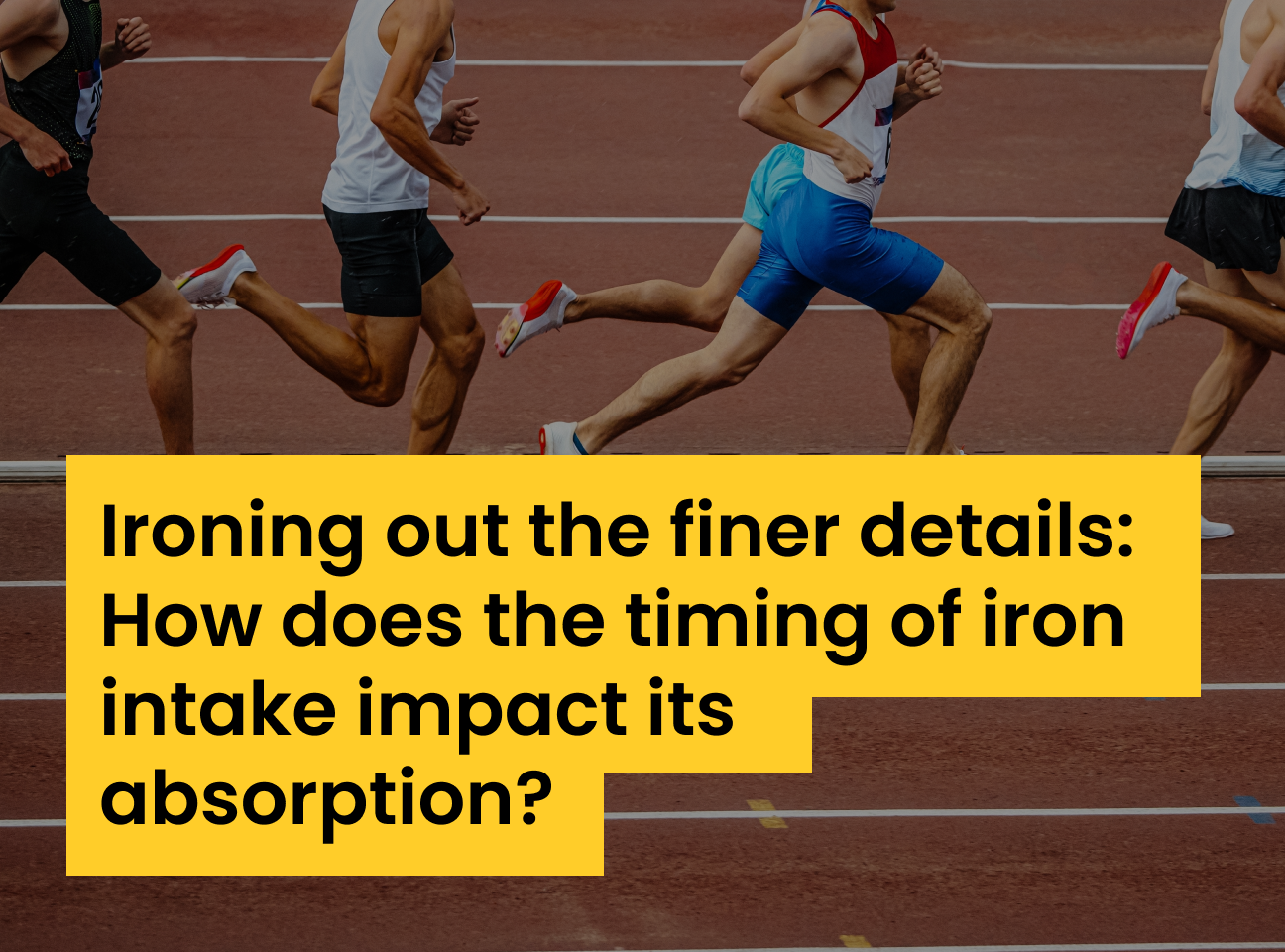
Ironing out the finer details: How does the timing of iron intake impact its absorption?
By Dr. Mark Hearris

Research: Iron Absorption in Highly Trained Male Runners: Does it Matter When and Where you Eat your Iron: A randomized control trial by McKay et al (2023)
Context: Iron plays a critical role in producing the oxygen-carrying protein haemoglobin within our red blood cells and the synthesis of adenosine triphosphate within the electron transport chain. For athletes, these processes are critical to success within their given sport, highlighting the need to avoid deficiency, which often manifests in symptoms of lethargy and tiredness and is associated with impaired aerobic power and reduced performance (Dellavalle & Haas, 2012). Nevertheless, iron deficiency remains a major concern among athletes, with up to 35% of female and 11% of male athletes being identified as deficient (Sim et al., 2019).
Whilst iron supplementation is recognised as an effective strategy to treat such deficiencies (McCormick et al., 2020), questions remain about when supplemental iron should be consumed to optimise its absorption. The timing of iron intake relates to within-day and exercise-induced variations in hepcidin concentrations — a hormone that regulates iron metabolism. Hepcidin concentrations are lower in the early hours of the morning and rise throughout the day but are also known to rise at around 3-6 hours post-exercise (Peeling et al., 2009), which could potentially impair the absorption of any iron being supplemented during this window.
The study: This study was separated into two related studies which were integrated into a 5-week training camp involving 18 highly trained male middle- to long-distance runners. These runners were highly trained, being classified as those competing at the national level and/or within 20% of world-lead performance levels. In relation to the topic of this research review, our attention will solely focus on Study 1 which took place during the first 10 days of camp, where participants undertook two treadmill running sessions (60 minutes at 65% VO2max) in a repeated-measures, counterbalanced design separated by 24 hours. To determine whether the timing of iron intake impacts its absorption, participants consumed a ferrous sulphate (iron) isotope tracer either before (30 minutes pre-exercise) or after (30 minutes post-exercise) the running session. During the testing period, nutritional intake was carefully controlled by providing athletes with a standardised (low iron) meal consisting of white toast and honey (29 g carbohydrate, 6 g protein, 2 g fat). Fourteen days after consuming the iron isotope tracer, blood samples were taken to determine the amount of the iron isotope that had been incorporated into red blood cells.
A closer look: Hepcidin regulation of iron absorption:
Hepcidin, a peptide hormone produced within the liver, is recognised as the master regulator of iron stores within the body whereby elevated hepcidin concentrations reduce the amount of iron absorbed into the circulation from our intestines. Importantly, hepcidin concentrations display diurnal variation throughout the day, where concentrations are lowest in the early morning and continue to rise throughout the day (Troutt et al., 2012), suggesting that supplementing with iron in the morning may be superior to supplementing in the evening when hepcidin concentrations are higher (McCormick et al., 2019). In addition to the diurnal variation, exercise can also increase hepcidin concentrations, which tend to peak 3-6 hours post-exercise (Peeling et al., 2009), with it suggested that iron supplementation should be avoided during this window.
Findings: As a reminder, the aim of Study 1 was to determine whether the timing of iron intake (30 minutes pre- or post-exercise) impacted upon its absorption and incorporation into red blood cells over the subsequent fourteen days. Before looking at this, it’s important to note that hepcidin concentrations increased to a similar extent at 3 hours post-exercise regardless of whether iron was supplemented pre- or post-exercise. Moving on to the absorption of iron, the data suggest that there was no significant difference in the amount of iron absorbed between the two experimental conditions (pre-exercise; 7.3% vs. post-exercise; 6.2%) suggesting that the timing of supplementation in close proximity to exercise is irrelevant. Finally, in support of the importance of hepcidin in controlling iron absorption, the researchers also demonstrated a strong correlation between hepcidin concentrations and iron absorption (r = – 0.62).
Relevance: The data from this study suggest that the timing of iron supplementation around exercise does not impact its absorption, leaving athletes with a much wider window (from 30 minutes before up to 30 minutes after exercise) in which they can consume their iron supplement. When taking a deeper dive into the results, you can see that pre-exercise supplementation increased iron absorption by 1.1%, which would equate to approximately 1 mg of the standardised 100 mg dose provided. Whilst we could question whether these differences are clinically meaningful over a prolonged period of supplementation (e.g., 1 mg daily over weeks and months) such small increases in bioavailability are unlikely to make much difference to overall iron status (Attwell et al., 2023). As practitioners, we should also recognise the interaction between supplementation timing and the athletes daily training and eating schedules. For example, if the athlete regularly consumes dietary components that may decrease iron absorption prior to training (e.g., coffee which contains substances such as phytates and polyphenols) it seems logical to schedule supplementation in the post-exercise period (within 30 minutes). In contrast, if the athlete performs regular fasted exercise, then supplementing iron pre-exercise may be recommended given that iron absorption is markedly higher in the fasted state (Cook, 2005) – albeit doing so may lead to unpleasant gastrointestinal issues in some athletes (Tolkien et al., 2015). As is often the case in our field, context is always key!
Recommended listening: Complement this research with the We Do Science podcast episode: Iron Considerations for the Athlete with Dr. Pete Peeling
References
Attwell, C., McKay, A., Sim, M., Dugan, C., Nicholas, J., Hopper, L., & Peeling, P. (2023). Timing is everything, but does it really matter? Impact of 8-weeks morning versus evening iron supplementation in ballet and contemporary dancers. Eur J Sport Sci, 1-8. https://doi.org/10.1080/17461391.2023.2224285
Cook, J. D. (2005). Diagnosis and management of iron-deficiency anaemia. Best Pract Res Clin Haematol, 18(2), 319-332. https://doi.org/10.1016/j.beha.2004.08.022
Dellavalle, D. M., & Haas, J. D. (2012). Iron status is associated with endurance performance and training in female rowers. Med Sci Sports Exerc, 44(8), 1552-1559. https://doi.org/10.1249/MSS.0b013e3182517ceb
McCormick, R., Moretti, D., McKay, A. K. A., Laarakkers, C. M., Vanswelm, R., Trinder, D., Cox, G. R., Zimmerman, M. B., Sim, M., Goodman, C., Dawson, B., & Peeling, P. (2019). The Impact of Morning versus Afternoon Exercise on Iron Absorption in Athletes. Med Sci Sports Exerc, 51(10), 2147-2155. https://doi.org/10.1249/mss.0000000000002026
McCormick, R., Sim, M., Dawson, B., & Peeling, P. (2020). Refining Treatment Strategies for Iron Deficient Athletes. Sports Med, 50(12), 2111-2123. https://doi.org/10.1007/s40279-020-01360-2
Peeling, P., Dawson, B., Goodman, C., Landers, G., Wiegerinck, E. T., Swinkels, D. W., & Trinder, D. (2009). Effects of exercise on hepcidin response and iron metabolism during recovery. Int J Sport Nutr Exerc Metab, 19(6), 583-597. https://doi.org/10.1123/ijsnem.19.6.583
Sim, M., Garvican-Lewis, L. A., Cox, G. R., Govus, A., McKay, A. K. A., Stellingwerff, T., & Peeling, P. (2019). Iron considerations for the athlete: a narrative review. European Journal of Applied Physiology, 119(7), 1463-1478. https://doi.org/10.1007/s00421-019-04157-y
Tolkien, Z., Stecher, L., Mander, A. P., Pereira, D. I., & Powell, J. J. (2015). Ferrous sulfate supplementation causes significant gastrointestinal side-effects in adults: a systematic review and meta-analysis. PLoS One, 10(2), e0117383. https://doi.org/10.1371/journal.pone.0117383
Troutt, J. S., Rudling, M., Persson, L., Ståhle, L., Angelin, B., Butterfield, A. M., Schade, A. E., Cao, G., & Konrad, R. J. (2012). Circulating Human Hepcidin-25 Concentrations Display a Diurnal Rhythm, Increase with Prolonged Fasting, and Are Reduced by Growth Hormone Administration. Clinical Chemistry, 58(8), 1225-1232. https://doi.org/10.1373/clinchem.2012.186866
